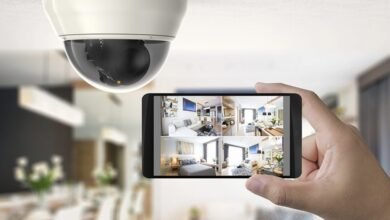The Evolution of Smart Homes and Iot: Step by Step Guide.

where the once fantastical concept of Smart Homes and the Internet of Things (IoT) has seamlessly transitioned from sci-fi narratives to our daily reality. In this transformative journey, the integration of technology into our living spaces has become more than a trend; it’s a revolution. The focus keyword, “Smart Homes and IoT,” encapsulates the essence of this evolution, where innovation and connectivity converge to redefine the way we live.
In the not-so-distant past, the notion of homes responding intelligently to our needs was confined to the pages of science fiction novels and the imaginations of visionary filmmakers. However, the relentless progress of technology has turned these futuristic dreams into tangible, everyday experiences. The Evolution of Smart Homes and IoT is more than just a chronological timeline; it’s a testament to the ever-expanding possibilities that technology brings to our doorstep. In the following exploration, we’ll trace the origins of Smart Homes, dive into the impact of the Internet of Things, and witness the birth of a new era where our homes are not just shelters but intelligent, adaptive companions in our daily lives.
The Evolution of Smart Homes and Iot
The Sci-fi Connection
The concept of Smart Homes has its roots in science fiction, where futuristic visions portrayed homes that could interact with inhabitants intelligently. From the iconic Jetsons to novels like Ray Bradbury’s Fahrenheit 451, the idea of a technologically advanced home captured the imagination long before it became a reality.
The Early Days of Smart Homes
The journey from fiction to reality began with the initial developments of Smart Homes. Early pioneers experimented with automation, introducing systems that controlled lighting and heating. These humble beginnings laid the foundation for the intelligent homes we know today.
Rise of the Internet of Things (IoT)
The true turning point came with the rise of the Internet of Things (IoT). This network of interconnected devices and systems enabled seamless communication, allowing various components of a home to work in harmony. The integration of IoT marked a significant leap towards creating truly smart and responsive living spaces.
Key Components of Smart Homes
To understand the evolution fully, let’s delve into the key components that make a home “smart.” From smart thermostats to voice-activated assistants, these devices create an ecosystem that enhances convenience and efficiency.
Connectivity and Interoperability
One of the critical challenges in Smart Home evolution is ensuring connectivity and interoperability. For a truly intelligent home, devices must communicate seamlessly. The industry is working towards standards that allow different brands and types of devices to work together effortlessly.
Benefits of Smart Homes
The benefits of embracing Smart Homes are extensive. Improved convenience, energy efficiency, and enhanced security are just a few aspects that contribute to their growing popularity. The ability to remotely control and monitor various aspects of your home adds a layer of convenience that was once only a dream.
Challenges in Smart Home Evolution
However, this technological revolution is not without challenges. Privacy concerns, data security, and the need for robust infrastructures pose hurdles in the path of widespread adoption. Addressing these challenges is crucial for the continued evolution of Smart Homes.
Future Trends
What does the future hold for Smart Homes and IoT? Predictions include further integration of artificial intelligence, more advanced automation, and a seamless blend of technology with our daily lives. The evolution is ongoing, with new innovations continuously shaping the landscape.
Real-life Applications
To better grasp the impact of Smart Homes, let’s explore real-life applications. From smart lighting systems to intelligent kitchen appliances, these technologies are transforming the way we interact with our living spaces.
Impact on Daily Life
Smart Homes are not just about gadgets; they are about enhancing our daily lives. From saving energy to providing security, the impact on daily routines is profound. The intuitive nature of these systems adapts to individual preferences, making homes more personalized and comfortable.
Security and Privacy Measures
Amid the excitement, concerns about security and privacy loom large. The article will discuss the measures in place to address these concerns, ensuring users can enjoy the benefits of Smart Homes without compromising their safety.
Consumer Adoption and Market Trends
Rapid Growth
Consumer adoption of Smart Home technologies has experienced rapid growth in recent years. As technology becomes more accessible and affordable, an increasing number of households are embracing Smart Home devices to enhance convenience, security, and energy efficiency.
Diverse Offerings
The market for Smart Home products and services is expanding, offering consumers a diverse range of options to choose from. From smart thermostats and lighting systems to voice-activated assistants and security cameras, there is a solution tailored to meet every household’s needs and preferences.
Integration with IoT
The integration of Smart Homes with the Internet of Things (IoT) has further fueled consumer interest. The ability to control and monitor various aspects of the home remotely via smartphones and other connected devices has become a compelling feature for many consumers.
Growing Awareness
As awareness of the benefits of Smart Homes continues to grow, so does consumer demand. More people are recognizing the potential cost savings, convenience, and security advantages that Smart Home technologies offer, driving further adoption and market expansion.
Innovative Solutions
The Smart Home market is characterized by continuous innovation, with companies constantly developing new and improved products and services. This innovation not only enhances the functionality and performance of Smart Home devices but also drives down costs, making them more accessible to a wider audience.
Environmental Impact
Energy Efficiency
Smart Homes significantly contribute to energy conservation by offering smart lighting systems, thermostats, and appliances that enable users to monitor and control their energy consumption. This not only reduces utility bills but also lessens the overall demand on energy resources.
Renewable Energy Integration
A growing trend in Smart Homes involves the integration of renewable energy sources. Solar panels, smart grids, and energy storage systems empower homeowners to generate their electricity, reducing reliance on non-renewable sources and contributing to a greener and more sustainable future.
Waste Reduction
Smart Home devices often come equipped with features that optimize resource usage. For instance, smart irrigation systems adjust watering schedules based on weather conditions, minimizing water waste. Additionally, smart appliances optimize usage patterns, leading to less wear and tear and a longer lifespan, ultimately reducing electronic waste.
Read More: Behind the Scenes: How Healthcare Works in Germany
Conclusion
The trajectory from sci-fi enchantment to the palpable reality of Smart Homes and the Internet of Things (IoT) is a testament to the remarkable strides in technology. The metamorphosis of our homes into intelligent, responsive spaces has not only surpassed the imaginings of science fiction but has also become an integral part of our daily existence.As we reflect on this evolution, it’s evident that Smart Homes are no longer a novelty; they are a necessity. The seamless integration of technology has not only elevated our comfort but has also ushered in an era of energy efficiency, enhanced security, and personalized living.
The journey from the speculative tales of futuristic homes to the present-day reality of interconnected living spaces underscores the adaptability and innovation of our ever-evolving technological landscape. In the years to come, the Evolution of Smart Homes and IoT is poised to continue, promising even more sophisticated advancements. As we embrace this intelligent future, it’s crucial to navigate the challenges, ensuring that privacy and security remain at the forefront. Our homes are no longer just shelters; they are dynamic hubs where technology enriches our lives in ways once deemed impossible. The transformation from sci-fi to reality is not just a technological marvel; it’s a glimpse into the limitless possibilities that lie ahead in our interconnected, smart world.
FAQs
Are Smart Homes only for tech enthusiasts?
No, Smart Homes are designed to enhance the lives of everyone, offering convenience, security, and energy efficiency to users of all backgrounds.
How secure are Smart Home systems?
Manufacturers implement robust security measures, but users must also take precautions like regular updates and secure passwords to ensure the safety of their Smart Homes.
Do Smart Homes save energy?
Yes, Smart Homes contribute to energy efficiency by allowing users to control and monitor their energy consumption more effectively.
Can I retrofit my existing home into a Smart Home?
Yes, many Smart Home devices are designed for easy integration into existing homes, making it possible to upgrade without significant renovations.
What is the future of Smart Homes?
The future holds even more advanced technologies, seamless automation, and increased integration with artificial intelligence, making Smart Homes an integral part of our daily lives.











